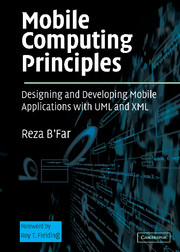Book contents
- Frontmatter
- Contents
- Foreword by Roy T. Fielding
- Acknowledgments
- SECTION 1 INTRODUCTIONS TO THE MAIN TOPICS
- SECTION 2 DEVICE-INDEPENDENT AND MULTICHANNEL USER INTERFACE DEVELOPMENT USING UML
- SECTION 3 ADDITIONAL DIMENSIONS OF MOBILE APPLICATION DEVELOPMENT
- SECTION 4 PUTTING THE PROJECT TOGETHER
- Chapter 15 The Mobile Development Process
- Chapter 16 Architecture, Design, and Technology Selection for Mobile Applications
- Chapter 17 Mobile Application Development Hurdles
- Chapter 18 Testing Mobile Applications
- Chapter 19 A Case Study
- References
- Index
Chapter 15 - The Mobile Development Process
from SECTION 4 - PUTTING THE PROJECT TOGETHER
Published online by Cambridge University Press: 03 September 2009
- Frontmatter
- Contents
- Foreword by Roy T. Fielding
- Acknowledgments
- SECTION 1 INTRODUCTIONS TO THE MAIN TOPICS
- SECTION 2 DEVICE-INDEPENDENT AND MULTICHANNEL USER INTERFACE DEVELOPMENT USING UML
- SECTION 3 ADDITIONAL DIMENSIONS OF MOBILE APPLICATION DEVELOPMENT
- SECTION 4 PUTTING THE PROJECT TOGETHER
- Chapter 15 The Mobile Development Process
- Chapter 16 Architecture, Design, and Technology Selection for Mobile Applications
- Chapter 17 Mobile Application Development Hurdles
- Chapter 18 Testing Mobile Applications
- Chapter 19 A Case Study
- References
- Index
Summary
Yazdi Koja Tashreef Darad? (Where has the one from Yazd descended upon?)
M. Ali Karimzadeh (my grandfather)INTRODUCTION
Thus far, in the first three sections of this text, we have focused on recognizing the new problems facing mobile application developers, tools to solve those problems, and how to use those tools to solve each specific problem.
Let us now look at the macro view of developing mobile applications. When we develop a stationary application, we gather requirements, lay out an architecture and design, select some tools to help us implement the application, develop the application, test, and deliver. Although this is a gross oversimplification of the application development process, it lays out the rough steps of developing stationary applications. There are development methodologies that go into each of these steps in a detailed manner and lay out a methodical approach to tackle them.
The question to ask now that we know how to deal with the detailed problems of mobile application development is whether these methodologies can be used as is or whether they must be modified to develop mobile applications.
BACK TO THE DIMENSIONS OF MOBILITY
If there is one thing you should know by now, it is that the dimensions of mobility are what make mobile applications different from their stationary counterparts. The dimensions of mobility and the mobile condition of the user, cumulatively, are what make the process of developing mobile applications different from the process of developing stationary applications.
- Type
- Chapter
- Information
- Mobile Computing PrinciplesDesigning and Developing Mobile Applications with UML and XML, pp. 755 - 772Publisher: Cambridge University PressPrint publication year: 2004



